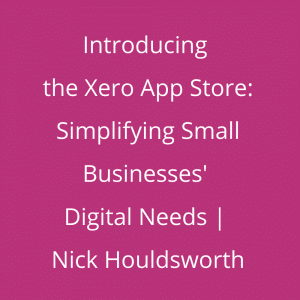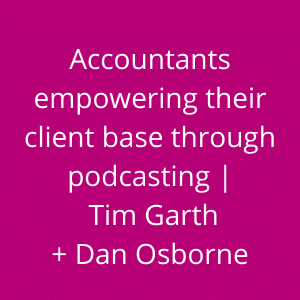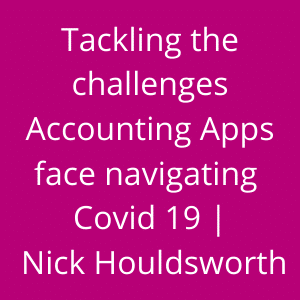Inspired by my talk with Heide Robson on her podcast Tax Talks (episode 168), I’m publishing a series of articles about Accounting Apps. You can listen to the original recording here.
No one is a dummy. Everyone is intelligent. Everyone has the skills and expertise in their own particular area. And what we’re trying to do with the Xero For Dummies book is to say, pick it up – you can pick it up at any any area, and it will explain how to get to the next step for you.
How did Xero for Dummies come about?
I had written two books, I’d written one book, was halfway through another book, and I was very prolific online on social media. Rod Drury, the founder and CEO of Xero contacted me via Twitter about a decade ago, and he asked me if I could write something about Xero and get it into iTunes and the Amazon stores. And I took his tweet, literally his tweet, to my publishers, and said, I’ve been approached about this. They went away, and they came back and they said, We want to do this, but we actually want to write this in the For Dummies series. They were very excited. And they said, Okay if you’re going to write for the For Dummies series, you have to go through the education process. I had to go through the education process of that.
Does the For Dummies brand have an education process?
Yes. I had to go through eight weeks, sort of a review and education process to understand the For Dummies style. I was given a lot of guidance on what the actual style was – things are very modular, things are very set out exactly the same way in every chapter. There are tips highlighted throughout the book. And there are five different types of tips, the ones like global tips, ones like a fast track tip. You highlight tips, you highlight notes, you also have appendix is that you work with and then the way you define things, and you always start a For Dummies book with a story. At the start of every chapter is a story, it’s kind of like my accounting life in a story.
I read you a story about the old lady who would ring the bell when all the columns had been added up. Yes, that was when I used to work in Cheltenham, that was one of the accounting lives stories I have in the book. I had to go through that process and then I had to put a financial proposal together, and I had to put a book proposal together, so there were two separate things as you kind of have to do a business plan for the book. You have to justify the financial benefits of doing the book, the market, how you promote it, and how other people will perceive it, and you put that together for the book. But then you have to also do the actual outline of the book, you have to say these are going to be the chapters, this is going to be the breakdown of the outline. I actually had to submit a two-page content outline of what the book would look like. And everything had to go through an immense approval process. And then I had to go through and write one single chapter, and then again, that had to be approved. And the approval of that chapter and everyone who approved me. I was assessed by about 30 different people across the world to make sure they agreed with the way I wrote and my style, and I got lots of feedback. It was a very intense two months process to go through that. And then I got approved as a For Dummies writer, and then I could start writing the book. I was working for two months without pay focused on just getting through the approval process.
With the For Dummies series, they are very involved throughout the whole book, they’re involved in every stage, they distribute it through their channels, they give you the templates, and they assign the editor, and they assign the person who will market it – everyone is assigned. I’m working on a team. And my role is to bring the content and the writing to it. It’s very much a team effort.
Was Xero involved at all in the writing?
Yes, Xero was very much involved, we were very fortunate that they supported the books, and their involvement was to technically check the book. And they spent a lot of time reviewing all chapters, and they go through and technically check them. That’s really important. And they provide all screenshots. That was really important that you’ve got this book out there, that has been technically checked by them that I write and that we kind of work together. You have the internal people reviewing it, but you have an external user sort of saying, Well, you know, the internal people may say, ‘Well, this is the way you should do something’, and I would be saying well, in reality, this is the way people are doing it. It gave me an opportunity to speak with people all over the world in terms of how they were doing particular processes within Xero.
What does the book cover?
It is a global book, and it said the book is focused on anyone globally can pick it up. The payroll element is extremely specialised, and it’s different throughout the world. For instance, in America, they don’t have it, you click into Gusto to do your payroll there in the United States of America. And payroll evolves so fast, that it’s very difficult to keep on top of it. I did actually write a Xero for Payrolls book, however, it almost became outdated, almost the day it was published, because it just evolves that that world evolves so far. We focused on the core, there is a section on tax compliance, and it does split out main elements of different tax compliance, such as different forms. I think there’s TPAR, different elements of what’s available in there in terms of texts compliant across the world. And then, some of the versions have the ability to do cheques, whereas the Australian version and the English version don’t have the ability to do cheques and them. That’s covered, and that’s included in there as well. It’s very much with an international flavour and nuanced into sort of the different areas. That was quite exciting. For example, ‘advisor’ is spelt differently across the different countries. And it’s spelled differently within Xero. That was interesting sort of having to navigate all those small things. But we said it’s been written in Australia, we use the Australian spelling primarily.
Which chapter was the hardest to write in Xero for Dummies?
It’s interesting, the easiest one to write was multi-currency because I really love multi-currency. And I thought it was just beautiful the way it works. And possibly the hardest one is reconciliation, because there are so many different nuances to the reconciliation, you can do it on one screen, you can drop into cash coding and do it on that screen, you can open up and you’ve got different elements of ‘find and recode’ and ‘discuss’ and then editing various areas. Probably the reconciliation and that that funnily enough was the one that they made me write first as well, which was unfortunate. But that was they requested I write that one first. And I would say possibly the hardest one. That is chapter eight Reconciling Your Bank Accounts.
What did writing the For Dummies book do for your professional profile?
Yeah, look, it’s interesting because I thought it would make a massive difference. But over time it has done. Over time, it’s given me a lot of credibility, a lot of people contact me about it. It really helped me improve my abilities as a writer, because I had the gift of working alongside some amazingly talented editors who are able to give me constant feedback, to help me improve my writing in a way that as an accountant, you just don’t have that opportunity to have someone every day, assess your writing and give you feedback on your writing. It really improved my writing. And that has helped me go forward. And so now I get the opportunity to do a lot more writing at a higher level with organisations because they know I can provide both the content and the writing. It has helped attract clients to the business this, but many of them, they’re very varied and random. It doesn’t attract a generalist client to the business. And normally, I have to refer them to say someone in a different country or someone who deals in this specific area. But it has certainly really helped my career step up another level. And I would encourage anyone who is a content specialist, would look at trying to apply to become a For Dummies writer, because I think it really can help your professional standing.
Talking about what do you do: You do public speaking, you’re a writer, you also run a public practice.
I work as an accounting and small business consultant. I’ve had a practice, for well over a decade now. I have a podcast, I facilitate a monthly meetup, where we talk about cloud accounting apps. And I facilitate forums where we again, talk about accounting apps, we do a lot of things, talking and focusing on and trying to push people to stretch themselves and talk about accounting apps. My day job I, I would typically call myself Mary Poppins, I jumped in, help someone in their file, and then jump out of it. I have lots and lots of smaller clients that I would typically work within that respect, I will help them improve the design of their Chart of Accounts, improve the way they’re using their jobs, or tracking or activities or the way they’re tracking things. Improve the way they’ve designed their reports, and then sort of work with them to connect in with business intelligence solutions that will help them surface information so they can use accurate and timely data to drive business decisions in their business. And I find that sort of say you implement a solution such as Float, which is a cash flow forecasting solution, I liken it to I have a dog called Charlie. And if I go outside with my dog and walk up the street, he walks very, very close to me. But if I put him on my lead, I have one of those really long leads. If I put him on one of those leads, he stretches as far away possible from me, because the lead gives him that security to stretch further away from me. He’ll stand about three metres away from me. And I think if you put in a solution like Float, which gives you cash flow forecasting abilities, it gives the business owner the confidence to sort of look at the scenario, the cash flow scenario of taking on a new employee, or investing in an asset or renting another building, and actually gives them the opportunity to test stretching themselves, and take those additional risks with the data to support the decision that they’re making.
Coming back to Xero, where do you see its strengths and weaknesses?
Okay, so where it has been very strong is the activation of bank feeds, it’s really important that you activate your bank feeds. And as many bank accounts, credit card accounts or PayPal accounts that you have, that they’re activated within Xero. It’s very good, the fact that you can have as many multiple simultaneous users accessing it at the same time. You can have a conversation between your bookkeeper, your accountant, and the small business owner, while you’re all looking at the same data that’s really important. The single ledger concert, which means that the tax professional when they go in and process work, it should actually be happening within Xero. Anything should happen within Xero. And the finalise results, the end of financial year results should be sitting within Xero, they shouldn’t have to take it out to another solution, manipulator, add some stuff in and then populate their other solution. It can simply happen within Xero, and it can publish through the Xero tax infrastructure that way. One of the frustrations I see – talking specifically about Xero – is that the tax professional ignores this or doesn’t understand this. And thus, charges the end-user, the small business owner, way too much money, and is not embracing this single ledger concept that the final year results of the business should be sitting within Xero. And they shouldn’t be there, sometimes magical numbers that they make up. They need to be sitting within Xero. One of the things is that has an asset register, so the assets should be depreciated within Xero. And if you are doing any depreciation, all of that data should sit within Xero, it shouldn’t sit out on a separate spreadsheet that never touches the small business accounts, and they never know about it until they work out all of their accounts are incorrect, and then as we have talked about the open API, and its ability to connect with solutions is really great. Typically, people say they find the interface quite easy to use, so it’s quite easy to move and navigate. You can go from your mobile device to your computer, your desktop computer, and you can access it from anywhere in the world. And that’s really great. Because I kind of say, I now have reached the stage where I do a lot of work-cations, which means my practice sits in my handbag. I can work from anywhere, so ongoing to be a New Zealand next week, and that’s not going to stop me working, because it’s okay that I will have some days that I’m in meetings in New Zealand. Other days, I can be fully functional and working because everything with Xero is in the cloud. And I can access all of the documentation I need because it’s all sitting there within Xero. Now one of the things that I think that I really wish they would improve is the ability to reconcile clearing accounts. I can’t reconcile the PAYG account or GST account, or when an app connects with Xero, it creates its own typical clearing account. And I really want the ability to reconcile all accounts to the balance sheet, so I know that they’re accurate. And currently, that is not easy to do in Xero.
Is Xero, the only accounting software you use?
I have an awareness of all of sort of the accounting software solutions, and sort of don’t really try not to play a favourite between all of them. I’ve been given the opportunity to write Xero for Dummies, which was sensational. And I also wrote a book on MYOB several years ago and try and sort of sit focused in the accounting apps world, and identify what are the great accounting apps out there. In my practice I use Xero, but I do have other ones running simultaneously alongside it.
The concept of Xero HQ was that it was going to show you alerts for your clients on what to do. You’re only going to see this if you’re a practice owner. And it should remind you where the BAS statements needed to be prepared, whether IAS needed to be prepared, whether payroll needed to be reviewed. And it’s typically reminding you of that. One of the difficulties is, is that you can’t define the reminders. It’s not necessarily too easy to actually define the reminders to your specific needs. It’s not an area I specifically use. But some people I’m sure would find it useful. What it should evolve to be is an area with a rich ability to define what alerts you want to and don’t want to see. And it should be if you just come in here and you know what to do every day.
When you wrote Xero for Dummies Who did you have in your mind? Who were you writing for?
The book is written for the small business owner. And it’s written to both explain in detail accounting concepts, but how and why they are applicable to their actual business. It should be stressed that no one is a dummy – everyone is intelligent, everyone has the skills and expertise in their own particular area. And what we’re trying to do with the For Dummies brand and with this book is to say, pick it up, pick it up at any area, and it will explain how to get to the next step for you. And it’s written them in a modular style. It will explain something, but it will reference back to another chapter if that contains information that you perhaps need. But you may only need to read one chapter to get you through that next stage, hopefully. And we very much took on feedback of anyone who ever gives us feedback on the book. And we try and incorporate that in, and people have different learning styles. Some people need to see videos, some people need to hear it some need to people need to try it out. And some people say reading very much helps them. A lot of people do come and tell me that they find the book very useful and full candidates and bookkeepers listening in. What I would suggest you do is if you are thinking of giving your clients the book, put your business card on the inside, because I’m not written the book to get work off everyone. I’m trying to support as many people as possible. But if you put your book on the inside of that cover, it will never leave the office and they will keep that book for years and years and years and they will have a reference to your business card on the inside of that book. And you can embed yourself with that client very, very simply and cheaply.
Somebody asked me what it was like working with Wiley Business – here is my response.
Q: What was pitching the chapter outlines and the concept for the book like?
I had to do a content plan and a financial / marketing plan for the book. It sounds like you are across those aspects, but it was a good exercise for me—getting everything out and into a business plan for the book. I primarily did that on my own and then presented it to the team. They asked me a few questions.
Q: How did you find the editorial support and collaboration during the writing process with Wiley?
I am now onto my 10th book with Wiley, so I’ll talk about the most recent experiences. Many of the Wiley team I’m dealing with, I’ve been working with for a decade. To their credit, they keep staff for a very long time. They’re all primarily Australian-based. When I did my first For Dummies book—which was my third book overall—the process was quite different, so I won’t touch on that unless you want me to.
Everyone is very pleasant to deal with, accommodating, and flexible. We work on a schedule and a deadline—it’s all been quite reasonable—and they’ve been quite supportive of me throughout.
One thing I’ll say, which I’m surprised about: there isn’t a collaborative network of For Dummies authors that I’ve been able to find. Maybe you’ve found one? I’m kind of disappointed there’s not a LinkedIn group, Facebook group, or WhatsApp group where For Dummies authors can share experiences, bounce off each other, and learn from each other. I thought that would be cool.
The whole process is actually quite lonely and isolating—I just kind of do it on my own. The editors—I just email them in, which is completely fine and sufficient, but it’s not like you’re working in a team. I like working on my own, but I didn’t form a large network of other interesting authors around me.
Q: What kind of marketing or promotional support does Wiley offer once the book is published?
A: They did print some bookmarks for me, which were kind of novel—I used them as my business card for a while. I would sneak them into bookstores and put them in the books.
The For Dummies series in Australia has a big promotion during March, and the books are promoted quite extensively in stores during that month.
Occasionally, they do pop-ups if I suggest an event, but that hasn’t happened for many years. If there was a suitable opportunity for a pop-up, it would be a good way to promote the book.
They have some Wiley Business websites you can write on, which gives you good SEO backlinks. They also have a newsletter—and I think there’s a podcast. I’ve had the opportunity to be featured in the newsletter once, but not the podcast.
So the marketing isn’t huge—but the brand is strong. There’s a whole tribe of people who, if they’re exploring something, will buy a For Dummies book. It really interests me.
If you go to a library, you’ll see there’s a For Dummies book on everything—like one on retired greyhound racing dogs! When I was doing my own due diligence, I borrowed 20 books and scanned through them all to see how they were written.
Q: What kind of grammar or formatting guidance does Wiley provide?
A: At the very start, they spent a long time talking about my grammar. I worked through that process with the editors to meet the For Dummies formatting and grammar style. I imagine they’ll give you guidance on that too. If I have a question, they’re always ready to answer—everyone’s very lovely.
Q: What advice would you give to someone considering publishing with Wiley?
A: Based on my experience, For Dummies gave me the opportunity to almost always have a book in a bookstore. I’d written other books, but they were only in bookstores for a fleeting second. For Dummies books are always in bookstores—and always bought by libraries.
There’s a contingent of people who do buy them. So if your goal is to influence and support people with your writing, it’s a good route.
You don’t make a huge amount of money, but it’s almost a stepping stone to something. Now, I’m in the accounting technology space, so it makes sense for me. I’m not sure if it makes sense in your space.
You do have the opportunity to include an “About You” page at the beginning or and, and a call to action. I’d be looking at what other people are doing and finding a way to get people to sign up to your newsletter or learn more about what you do. That way, anyone who taps into the book connects with you completely. You just need to navigate how to do that.





